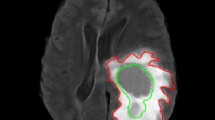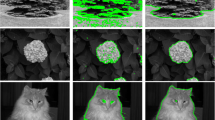Abstract
Thresholding techniques for image segmentation is one of the most popular approaches in Computational Vision systems. Recently, M. Albuquerque has proposed a thresholding method (Albuquerque et al. in Pattern Recognit Lett 25:1059–1065, 2004) based on the Tsallis entropy, which is a generalization of the traditional Shannon entropy through the introduction of an entropic parameter q. However, the solution may be very dependent on the q value and the development of an automatic approach to compute a suitable value for q remains also an open problem. In this paper, we propose a generalization of the Tsallis theory in order to improve the non-extensive segmentation method. Specifically, we work out over a suitable property of Tsallis theory, named the pseudo-additive property, which states the formalism to compute the whole entropy from two probability distributions given an unique q value. Our idea is to use the original M. Albuquerque’s algorithm to compute an initial threshold and then update the q value using the ratio of the areas observed in the image histogram for the background and foreground. The proposed technique is less sensitive to the q value and overcomes the M. Albuquerque and k-means algorithms, as we will demonstrate for both ultrasound breast cancer images and synthetic data.








Similar content being viewed by others
Notes
We define the composed distribution, also called direct product of \(P = [p_1, \ldots, p_n]\) and \(Q = [q_1,\ldots, q_n], \) as \(P \ast Q =\{p_iq_j\}_{i,j},\) with \(1 \leq i \leq n\) and \(1 \leq j \leq m\)
References
Aback T, Baris U, Sankur B (1997) The performance of thresholding algorithms for optical character recognition. In: International conference on document analysis recognition ICDAR’97, pp 697–700
Albuquerque MP, Albuquerque MP, Esquef IA, Mello ARG (2004) Image thresholding using Tsallis entropy. Pattern Recognit Lett 25:1059–1065
Bhanu B (1986) Automatic target recognition: state of art survey. IEEE Trans Aeroespacial Electron Syst AES-22: 364–379
Chen S, Lin W, Chen C (1992) Split-and-merge image segmentation based on localized feature analysis and statistical tests. CVGIP Graph Models Image Process 53(5):457–475
Duda RO, Hart PE, Stork DG (2000) Pattern classification, 2nd edn. Wiley, New York
Geman D, Geman S (1984) Stochastic relaxation, gibbs distribution and bayesian restoration of images. IEEE Trans Patterns Anal Mach Intell (PAMI) 6:721–741
Giraldi GA, Oliveira AAF (1999) Dual-snake model in the framework of simplicial domain decomposition. In: Technical poster of international symposium on computer graphics, image processing and vision—SIBGRAPI’99, pp 103–106
Giraldi GA, Schaefer L, Rodrigues PS (2000) Gradient vector flow models for boundary extraction in 2d images. In: Proceedings of the 8th international conference on computer graphics and image—IASTED CGIM 2005
Giraldi GA, Strauss E, Oliveira AAF (2000) Boundary extraction approach based on multi-resolution methods and the t-snakes framework. In: Proceedings of the international symposium on computer graphics, image processing and vision—SIBGRAPI’00, Gramado, Rio GRande do Sul, Brazil
Giraldi GA, Strauss E, Oliveira AAF (2000) A boundary extraction method based on dual-t-snakes and dynamic programming. In: Proceedings of the IEEE computer society conference on computer vision and pattern recognition, CVPR’2000
Gonzalez RC, Woods RE (1992) Digital image processing. Addison-Wesley, Reading
Jain AK, Murty MN, Flynn PJ (1999) Data clustering: a review. ACM Comput Surv 31(3):264–323
Kamel M, Zhao A (1993) Extracting of binary character/graphics image from grayscale document images. Graph Models Image Process 55(3):203–217
Kanungo T, Dom B, Niblack W, Steele D (1994) A fast algorithm for mdl-based multi-band image segmentation. In: Proceedings of IEEE conference on computer vision and pattern recognition, pp 609–616
Kapur JN, Sahoo PK, Wong AKC (1985) A new method for gray-level picture thresholding using the entropy of the histogram. Comput Graph Image Process 29:273–285
Pun T (1981) Entropic thresholding: a new approach. Comput Graph Image Process 16:210–239
Rodrigues PS, Giraldi GA (2004) Parameter estimation with a bayesian network in medical image segmentation. In Proceeding of the 17th international conference of computer graphics and image—IASTED-CGIM, Kauai, Hawaii, USA, October 2004
Rodrigues PS, Giraldi GA, Chang RF, Suri J (2006) Non-extensive entropy for cad systems of breast cancer images. In: IEEE Computer Society (ed) Proceedings of Brazilian symposium on computer graphics and image processing, Belo Horizonte, Brazil, pp 121–128
Rodrigues PS, Giraldi GA, Suri J (2006) Object tracking combining Haudorff distance, HSV histogram and non-extensive entropy, vol 1, chap 15. Springer, New York
Sahoo P, Soltani S, Wong A, Chen Y (1988) A survey of thresholding techniques. Comput Vis Graph Image Process 41(1):233–260
Sezgin M, Sankur B (2001) Comparison of thresholding methods for non-destructive testing applications. In: International conference on image processing, IEEE ICIP’2001, pp 764–767
Sezgin M, Sankur B (2004) Survey over image thresholding techniques and quantitative performance evaluation. J Eletron Imaging 13(1):146–165
Sezgin M, Tasaltin R (2000) A new dichotomization technique to multilevel thresholding devoted to inspections. Pattern Recognit Lett 21:151–161
Shannon C, Weaver W (1948) The mathematical theory of communication. University of Illinois Press, Urbana
Shapiro LG, Stockman GC (2001) Computer vision. Prentice Hall, Upper Saddle River
American Cancer Society (2004) Cancer facts & figures
Tsallis C (1999) Nonextensive statistics: theoretical, experimental and computational evidences and connections. Braz J Phys 29(1):1–35
Tsallis C (2001) Nonextensive statistical mechanics and its applications. In: Series lecture notes in physics. Springer, Berlin. The bibliography of the subjects is regularly updated at http://tsallis.cat.cbpf.br/biblio.htm
Author information
Authors and Affiliations
Corresponding author
Rights and permissions
About this article
Cite this article
Rodrigues, P.S., Giraldi, G.A. Improving the non-extensive medical image segmentation based on Tsallis entropy. Pattern Anal Applic 14, 369–379 (2011). https://doi.org/10.1007/s10044-011-0225-y
Received:
Accepted:
Published:
Issue Date:
DOI: https://doi.org/10.1007/s10044-011-0225-y




